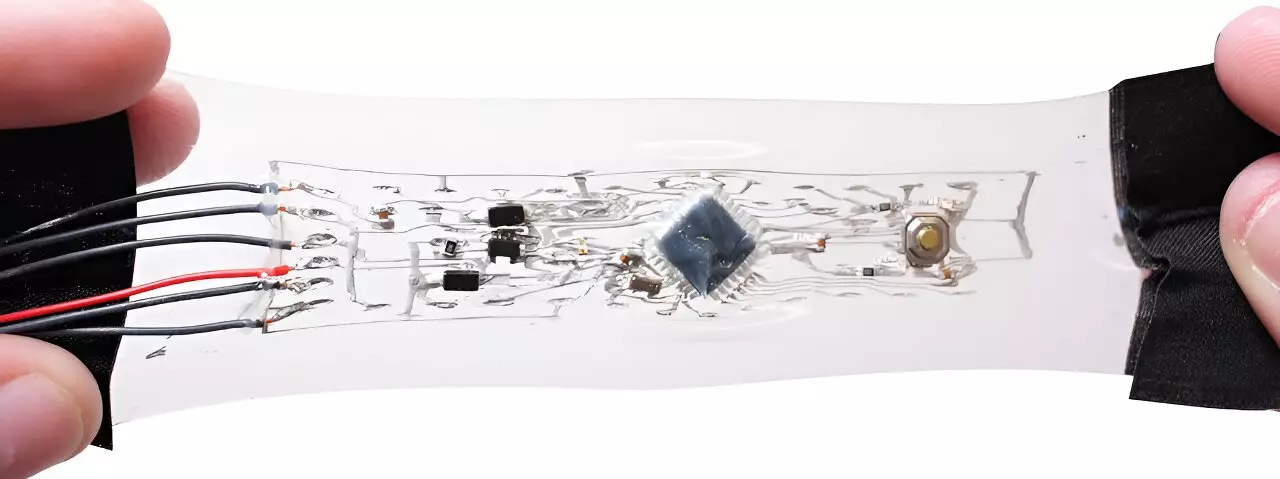In recent years, the evolution of soft robotics has garnered significant attention across various disciplines, ranging from medical assistance to search-and-rescue operations. Soft robots promise not only adaptability and versatility but also the potential for safer interactions with humans and fragile environments. Yet, despite the promise, a persistent challenge remains: the effective integration of complex electronic systems that are intrinsically rigid into the inherently flexible structures of soft robots. Fortunately, recent advancements from the research team led by Professor Rebecca Kramer-Bottiglio are paving the way toward achieving this integration seamlessly.
A major hurdle for those involved in soft robotics is the interface between hard electronics and soft materials. Traditional rigid circuit components often become a limiting factor in the design and functionality of soft robots. Designers typically resort to external circuit boards to sidestep this incompatibility, resulting in a loss of potential performance. This mismatch restricts the creative freedom of roboticists. The breakthrough made by Kramer-Bottiglio’s lab, however, proposes a paradigm shift: developing stretchable electronic counterparts to the Arduino platform, which serves as a backbone for numerous electronic applications.
These innovations allow the integration of electronics that can stretch to several times their original dimensions without compromising performance, marking a significant development in the field of soft robotics. This flexibility addresses long-standing issues associated with rigid circuit boards and opens the door for more innovative designs.
At the core of Kramer-Bottiglio’s research is a redesign of well-known open-source electrical platforms. The team successfully created stretchable versions of devices like the Arduino Pro Mini and Lilypad. In their endeavor, they focused on constructing robust circuits that retain functionality even in high-strain situations, positioning the electronics in areas typically faced with maximal tension. This adaptability not only enhances the overall performance of soft robots but also liberates designers from adhering to limiting design constraints previously imposed by rigid electronics.
As a testament to their research, the stretchable electronics developed are capable of performing dynamic tasks and demonstrating significant elasticity. Their ability to stretch more than three to four times their original form represents a monumental achievement for soft robotics, indicating a marked departure from outdated approaches that rendered similar projects unfeasible.
The research findings underscore an essential principle in innovation: accessibility is key. The team has made all fabrication techniques, materials, and circuit designs openly available, encouraging further exploration and application across various fields. Such democratization of technology is crucial for advancing soft robotics, as it eliminates the requirement for specialized equipment and expertise, thereby inviting a broader range of innovators to contribute to the sphere.
The approach they adopted involved the use of gallium-based liquid metal, which, when exposed to oxygen, transforms into a paste-like formulation. This enhances its usability for creating flexible electronic circuits. The resulting circuits can easily adhere to both rigid components and compliant substrates, enhancing their potential for use in a multitude of robotic applications.
This pioneering work has implications that ripple beyond robotics and into the realm of wearable technology. For instance, the application of stretchable electronics in managing and aiding injured limbs has shown promising potential. The research team successfully embedded circuitry within prototypes designed to conform to human joints— a critical deployment zone due to frequent movement and flexion.
This exciting development leads to not only improved usage of technology in rehabilitation but also sets the stage for future research in wearable assistive devices. These applications exemplify the capability of stretchable electronics to revolutionize the way technology interfaces with the human body, providing support and flexibility without sacrificing mobility.
Overall, the research spearheaded by Kramer-Bottiglio and her team signifies a monumental advancement in the field of robotics. By overcoming the conventional challenges associated with integrating rigid circuits into flexible environments, their innovations represent a crucial step toward the creation of functional, sophisticated soft robots and wearable devices. The ability to adapt electronics to stretchable forms offers tremendous potential for countless applications, and as the technology continues to mature, the future of robotics appears increasingly flexible and promising.
Improvements and continued exploration in this field will not only enhance the capabilities of robotic systems but also usher in a new era where human-robot interaction is not just possible but intuitively fluid. As this research unfolds, one can only anticipate the transformative impacts it will have across various industries to come.


Leave a Reply